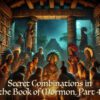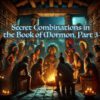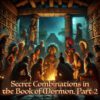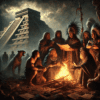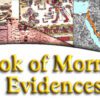I received a thoughtful question from a former member of the Church who struggles with our belief that a sacrifice of the Messiah was really necessary to save mankind. Based on his knowledge of Jewish thought on sacrifices and salvation, it looks as if the Old Testament does not really require that a Messiah must die in order for God to forgive sins. Common explanations of the Atonement known as the “satisfaction theory” (satisfying the honor or justice of God, which was offended by human sin), “penal substitution theory” (suffering for our sins as a substitute for required punishment), “ransom theory” (suffering to pay a ransom to the forces of evil to liberate us), etc., don’t directly follow from ancient Jewish teachings. He said that he can accept the Book of Mormon as something that Joseph Smith could not possibly have fabricated, but this gap regarding the need for the Atonement has been a major stumbling block for him. So he struggles with the very foundation of our faith, the need for the Atonement.
I have seen others struggle with this but haven’t said much on the issue. But his clearly written and thoughtful question stirred me to reply. My intended short answer became longer than I expected as I saw some new things along the way. What follows is my response.
I think you have a reasonable point. Based on the modern Jewish perspective and the Old Testament and other surviving Jewish writings, it can be argued that the Atonement was not necessary. But there were also ancient divisions in Jewish thought that may have resulted in the loss of some of the most vital ancient scripture that could have helped make the need for Atonement much more clearly presented. If knowledge of the Messiah as the sacrificial Lamb of God has been lost but was present anciently, that could be a good reason to reconsider the Atonement.
If the Book of Moses, for example, truly reflects ancient scripture, then it brings a powerful witness for the necessity of the Atonement. One passage of note refers to the Lamb (of God) that needed to be sacrificed, found in Moses 7:
44 And as Enoch saw this, he had bitterness of soul, and wept over his brethren, and said unto the heavens: I will refuse to be comforted; but the Lord said unto Enoch: Lift up your heart, and be glad; and look.
45 And it came to pass that Enoch looked; and from Noah, he beheld all the families of the earth; and he cried unto the Lord, saying: When shall the day of the Lord come? When shall the blood of the Righteous be shed, that all they that mourn may be sanctified and have eternal life?
46 And the Lord said: It shall be in the meridian of time, in the days of wickedness and vengeance.
47 And behold, Enoch saw the day of the coming of the Son of Man, even in the flesh; and his soul rejoiced, saying: The Righteous is lifted up, and the Lamb is slain from the foundation of the world; and through faith I am in the bosom of the Father, and behold, Zion is with me.
Ah, but surely this cannot be an ancient Jewish teaching, for the concept of the Lamb of God comes from early Christian times, right (John 1:29, 36, for example)? And so the Book of Moses and the Book of Mormon in testifying of the coming of and necessity of the sacrificial Lamb of God are just regurgitating Christian thought, right?
It turns out that the Lamb of God that John talks about was likely drawing upon an older Jewish concept. There are at least two very different surviving Jewish documents speaking of that figure. I’m attaching a short note that will accompany a paper by a wonderful Jewish scholar, Dr. Meir Bar-Ilan, in a paper, “The Heavenly Lamb, Sacrifices on the Heavenly Altar, and the Song of the Lamb,” soon to be published in Interpreter: A Journal of Latter-day Saint Faith and Scholarship. I don’t have permission to send you his paper ahead of publication, but I can attach my short response. His paper discusses the recently translated ancient Jewish document, Words of Gad the Seer, that was found among the old Jewish colony in Cochin, India. In its first chapter, Gad has a vision of the Lamb of God who comes and offer sacrifices (no, he is not sacrificed himself). The Lamb of God is an important but ysterious part of this ancient text. I hope you will enjoy that paper when it comes out. The other source is “The Testaments of the Twelve Patriarchs” (see pp. 354 and 356 in the linked source). This is found in R. H. Charles, “The Testaments of the Twelve Patriarchs,” in The Apocrypha and Pseudepigrapha of the Old Testament, vol. 2 (Oxford: Oxford Press, 1913), 354, 356.
[Here I attached a Word document with my response on Dr. Bar-Ilan’s paper on the Lamb of God, which will soon be published with his paper.]
I also briefly discuss the Lamb of God in my review of Dr. Bar-Ilan’s translation of Words of Gad the Seer at https://journal.interpreterfoundation.org/the-words-of-gad-the-seer-an-apparently-ancient-text-with-intriguing-origins-and-content/. I hope you’ll read that, too.
With that background in mind, let me add my own witness and evidence for the antiquity of the Book of Moses involving some work with Noel Reynolds. It’s a long story, but basically, there are surprising textual connections between the Book of Moses and the Book of Mormon that defy our normal assumptions. Deliberate textual clues suggest the translation of both texts was strewn with deliberate intertextuality, wherein the Book of Mormon text frequently sometimes makes allusions to backstories or more complete concepts provided in the Book of Moses, as if something very much like our Book of Moses were on the brass plates, and thus was influencing many Book of Mormon writers, especially those like Nephi and Alma who relied heavily on the brass plates.
This frequent one-way direction of influence is so puzzling because Joseph Smith began the translation of the Bible, starting with the revelatory outpouring of Moses 1, well after the Book of Mormon had been finished. Thus, we would expect similarities in language to reflect the Book of Moses occasionally employing Book of Mormon language. But there are many cases where that makes no sense and it is clear that the direction of influence is from the Book of Moses to the Book of Mormon. Building in intertextuality with rich explanatory power in which a later text strongly influences an earlier text that was written before the later project had even begun is a remarkable achievement and one that would seem to be impossible for Joseph Smith, especially just dictating for hours out of a hat without notes. What this does is create a compelling and independent mountain of evidence IMO, that the Book of Moses and the Book of Mormon are genuine ancient texts given by revelation that preserved remarkable intertextual allusions in common language.
That must sound crazy, but I hope you’ll read some of my work on this at Interpreter. It’s been the strangest thing for me, honestly. The number of parallels not easily explained by using KJV language between the two texts now stands at 141. The latest paper on the topic is at https://interpreterfoundation.org/further-evidence-from-the-book-of-mormon-for-a-book-of-moses-like-text-on-the-brass-plates/, which links to the earlier works. There is a new one I’ll be posting on my blog at AriseFromTheDust.com shortly that will also show the very non-random distribution of these parallels in the Book of Mormon and provide some further clues and new parallels. I hope you’ll consider this “strange” line of reasoning, for it adds vitality to the Book of Moses as an ancient record testifying of the Messiah and the Lamb of God, and strengthens the case for Nephi as a real living prophet familiar with a record like our Book of Moses. And that means that his witness of the sacrificial Lamb of God is not a modern projection into a “truthy” work of inspired fiction, but the work of a real prophet familiar with other sacred texts on the brass plates that testified of the Messiah.
The Book of Mormon also offers a further reason for the need of that sacrifice: by taking on the sins and pains of all humanity to heal us with His stripes, the Messiah comes to truly know us, to feel our pain, and to be able to love us with total empathy, the bowels of mercy, and save us with the infinite love that this infinite Atonement creates. In other words, the Atonement wasn’t just a bookkeeping act to compensate for sin. It was a transformation act for the Messiah himself, making Him more fully able to draw us to Him and heal us with his infinite, perfected love. Consider these passages on the “bowels of mercy”:
Mosiah 15:9
Having ascended into heaven, having the bowels of mercy; being filled with compassion towards the children of men; standing betwixt them and justice; having broken the bands of death, taken upon himself their iniquity and their transgressions, having redeemed them, and satisfied the demands of justice.** Alma 7:12 **
And he will take upon him death, that he may loose the bands of death which bind his people; and he will take upon him their infirmities, that his bowels may be filled with mercy, according to the flesh, that he may know according to the flesh how to succor his people according to their infirmities.Alma 26:37
Now my brethren, we see that God is mindful of every people, whatsoever land they may be in; yea, he numbereth his people, and his bowels of mercy are over all the earth. Now this is my joy, and my great thanksgiving; yea, and I will give thanks unto my God forever. Amen.** Alma 34:15 **
And thus he shall bring salvation to all those who shall believe on his name; this being the intent of this last sacrifice, to bring about the bowels of mercy, which overpowereth justice, and bringeth about means unto men that they may have faith unto repentance.3 Nephi 17:6, 7 (Christ speaking)
And he said unto them: Behold, my bowels are filled with compassion towards you.Have ye any that are sick among you? Bring them hither. Have ye any that are lame, or blind, or halt, or maimed, or leprous, or that are withered, or that are deaf, or that are afflicted in any manner? Bring them hither and I will heal them, for I have compassion upon you; my bowels are filled with mercy.
“Bowels of mercy” is a literal translation of a Hebrew term typically translated as tender mercies, mercy, lovingkindness, etc. It is not found as such in the KJV Bible, though Paul asks us to put on “bowels of mercies” in Colossians 3:12 (passages with both words include Jeremiah 31:20, Isaiah 63:15, and Philippians 2:1). Why was this Hebraism preserved in the Book of Mormon? I suspect it is because it is a literal concept that we can relate to, the feeling in our gut when we consider someone’s intense pain. For the Book of Mormon’s purposes, when speaking of God’s love for us, the more literal translation may be more suitable and compelling than, say, “tender mercies” — though this is also commonly used in the Book of Mormon. But when speaking of the Atonement, it makes sense to me to use the more literal and graphic term, “bowels of mercy.” This is also a concept that may be reflected in the Book of Moses in Enoch’s vision, shortly before the verses I cited above from Moses 7.
In Moses 7, we learn that compassion of the future Messiah is reflected by the compassion that the Father has for His children, a God who weeps, to the surprise of Enoch (Moses 7:28, 29). God explains why the heavens weep for those who do not repent, and then Enoch has a transformational experience of his own:
35 Behold, I am God; Man of Holiness is my name; Man of Counsel is my name; and Endless and Eternal is my name, also.
36 Wherefore, I can stretch forth mine hands and hold all the creations which I have made; and mine eye can pierce them also, and among all the workmanship of mine hands there has not been so great wickedness as among thy brethren.
37 But behold, their sins shall be upon the heads of their fathers; Satan shall be their father, and misery shall be their doom; and the whole heavens shall weep over them, even all the workmanship of mine hands; wherefore should not the heavens weep, seeing these shall suffer?
38 But behold, these which thine eyes are upon shall perish in the floods; and behold, I will shut them up; a prison have I prepared for them.
39 And that which I have chosen hath pled before my face. Wherefore, he suffereth for their sins; inasmuch as they will repent in the day that my Chosen shall return unto me, and until that day they shall be in torment;
40 Wherefore, for this shall the heavens weep, yea, and all the workmanship of mine hands.
41 And it came to pass that the Lord spake unto Enoch, and told Enoch all the doings of the children of men; wherefore Enoch knew, and looked upon their wickedness, and their misery, and wept and stretched forth his arms, and his heart swelled wide as eternity; and his bowels yearned; and all eternity shook.
That last verse is a powerful one to me. Like Christ stretched out on the cross, Enoch stretches out his arms as divine power helps him know the pains of humanity, causing his heart to swell as “wide as eternity,” and “his bowels yearned.” This was not an atonement, but an echo of that majestic moment that would bring its own shaking to the earth. Enoch’s miraculous encounter with God’s perspective on humanity was an overwhelming event of compassion and empathy. “And his bowels yearned.” And so do the bowels of the Father (“The Son can do nothing of himself, but what he seeth the Father do: for what things soever he doeth, these also doeth the Son likewise” — John 5:19) and the bowels of the transformed Messiah, who, through His infinite suffering, fully yearns for us, He having taken our pains upon Him, now having total understanding, empathy, sympathy, and tender mercy. He fully understands not just through knowledge and logic, but through sharing our pain and yearning for us in His bowels.
This total compassion and His willing sacrifice of love for us in spite of our sins gives us faith to repent — if He loved us that much, we must be worth something to Him, and maybe, maybe we can turn to Him and be healed with that love. And thus we can be part of the joyful fruits that achieve “the intent of this last sacrifice, to bring about the bowels of mercy, which overpowereth justice, and bringeth about means unto men that they may have faith unto repentance.” His bowels of mercy, His yearning for us, His love perfected in infinite and merciful suffering as He tasted all our pain, brings us unto Him and gives us confidence that He understands and forgives, and thus we can have total faith in His Atonement, faith unto repentance. This was the ultimate obedience that made Christ become fully perfect and the author of eternal salvation (Hebrews 5:8,9). The Atonement, from this perspective, was not merely a bookkeeping exercise or a ransom payment, but a transformative act of mercy that perfected the Messiah and transforms us with his bowels of mercy that draw us to His love and compassion. His infinite love can transform us and gives us the miraculous gift of charity, in which we, too, like Enoch, can yearn with divine love for the well-being of others.
I’d be happy to discuss this further. I’m not an expert on Jewish matters at all and may not be addressing your concerns very well, but I’d be happy to chat sometime if you wish.
Sorry for such a belated response and perhaps a wild, rambling one at that. But there’s something deep and ancient going on in the relationship between the Book of Moses and the Book of Mormon that creates evidence for the reality of ancient Hebrew prophets recognizing the need for the great sacrifice of the Lamb of God.


